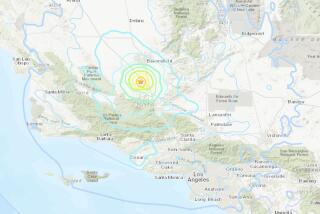7.2 Quake Off Northern California Coast Causes No Major Damage
FERNDALE, Calif. — A magnitude 7.2 earthquake struck Thursday off the Humboldt County coast in a seismically active area where three tectonic plates converge, but the quake was far enough out to sea that no major damage and no injuries resulted.
The 8:15 a.m. temblor was placed by the U.S. Geological Survey on the Mendocino Fault about 90 miles west-southwest of Eureka. It was felt as a long, gentle rolling motion through much of Northern California and southwestern Oregon.
The quake’s epicenter was under the Pacific, but no tsunami or seismic sea wave formed because the quake’s movement was horizontal rather than vertical.
In this colorful town of Victorian-style homes and businesses, the quake shook just a few books from the library shelves, but it did remind uneasy residents of their recent earthquake history, which included a magnitude 7.1 temblor two years ago.
That large quake in 1992 and its aftershocks damaged 300 homes, injured 356 people and caused $50 million in damage. Thursday’s quake was further offshore and, aside from knocking one house off its foundation in the town of Fortuna, barely disturbed area residents.
“It was not like the last ones,” said Frank Mathes, Ferndale’s public works director. “This was just a big roller. There was no damage of any kind, anywhere. It’s amazing considering the magnitude. . . . People are astounded to hear the magnitude.”
Stanford University scientists recently estimated that if a similar but slightly smaller quake struck along the Newport-Inglewood fault in urban Los Angeles, it would do $125 billion to $145 billion in damage. But this area of California’s North Coast is sparsely populated except for scattered towns such as Ferndale and Eureka, about 20 miles north.
The quake Thursday was the second strongest to hit in or close to California in the 1990s, eclipsed only by the June 28, 1992, quake centered in the Mojave Desert near Landers that was magnitude 7.3. The latest quake was the fourth of magnitude 7 or greater in the last five years.
Thursday’s quake occurred close to the “triple junction” of the North American, Pacific and Gorda tectonic plates and not far from the potentially deadly Cascadia subduction zone, where scientists have warned that a gigantic quake could devastate the Northwest coast.
Tectonic plates are large land masses that float on the molten core of the Earth. The areas where they meet are often associated with volcanic and earthquake activity. A subduction zone is a place where one plate pushes under another.
Lori Dengler, a seismologist at Humboldt State University, said the Mendocino Fault, on which Thursday’s quake occurred, forms the boundary between the Gorda and Pacific plates. Although a different fault was involved in the 1992 quakes, she thinks that it was close enough so that the temblor may have been a response to the 1992 quakes.
She said she did not think that Thursday’s quake indicated that the feared Cascadia subduction zone quake would happen soon.
Bill Ellsworth of the U.S. Geological Survey in Menlo Park, Calif., said the quake ruptured a segment of the Mendocino fault that was between two segments that ruptured in 1954 and 1984.
The type of rupture, Ellsworth said, was similar, on a much smaller scale, to that of the great San Francisco earthquake of 1906. But since the segments on either side had ruptured fairly recently, he shared Dengler’s view that no larger earthquake is imminent.
Paddock reported from Ferndale and Reich reported from Los Angeles.
Coastal Earthquake
A magnitude 7.2 earthquake struck in Northern California Thursday morning. It was centered in the ocean about 90 miles west-southwest of Eureka.
More to Read
Sign up for Essential California
The most important California stories and recommendations in your inbox every morning.
You may occasionally receive promotional content from the Los Angeles Times.










